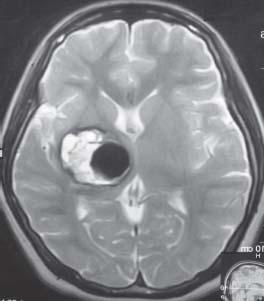Case 29 Cavernous Angioma
Julius July and Eka Julianta Wahjoepramono
Fig. 29.1 T2-weighted magnetic resonance image showing a lesion involving the right basal ganglia and thalamus.
- A 19-year-old woman presents with chronic headache since early childhood. For the last 6 months her headaches have become progressively worse. She also felt that her left side was becoming weaker.
- Her left upper and lower extremities were weak since early childhood.
- There is no history of seizure.
- On initial assessment, she has left-side weakness and left hemi-hypesthesia.
- She was referred from other hospital with the magnetic resonance imaging (MRI) study shown. (Fig. 29.1)
< div class='tao-gold-member'>
 Clinical Presentation
Clinical Presentation Questions
Questions Answers
Answers


